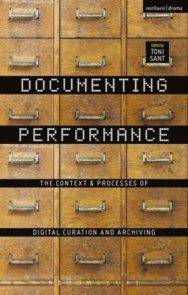
ABOUT THIS BOOK
PUBLISHER: Bloomsbury Publishing PLC (Digital)
FORMAT: Electronic book text
ISBN: 9781472588197
RRP: £18.99
PAGES: 392
PUBLICATION DATE:
March 23, 2017
BUY THIS BOOK
As an Amazon Associate and Bookshop.org affiliate we earn from qualifying purchases.
Documenting Performance: The Context and Processes of Digital Curation and Archiving
Toni Sant
Performance in the digital age has undergone a radical shift in which a once ephemeral art form can now be relived, replayed and repeated. Until now, much scholarship has been devoted to the nature of live performance in the digital age; Documenting Performance is the first book to provide a collection of key writings about the process of documenting performance, focused not on questions of liveness or the artistic qualities of documents, but rather on the professional approaches to recovering, preserving and disseminating knowledge of live performance.Through its four-part structure, the volume introduces readers to important writings by international practitioners and scholars on:* the contemporary context for documenting performance* processes of documenting performance* documenting bodies in motion* documenting to createIn each, chapters examine the ways performance is documented and the issues arising out of the process of documenting performance. While theorists have argued that performance becomes something else whenever it is documented, the writings reveal how the documents themselves cannot be regarded simply as incomplete remains from live events. The methods for preserving and managing them over time, ensuring easy access of such materials in systematic archives and collections, requires professional attention in its own right. Through the process of documenting performance, artists acquire a different perspective on their own work, audiences can recall specific images and sounds for works they have witnessed in person, and others who did not see the original work can trace the memories of particular events, or use them to gain an understanding of something that would otherwise remain unknown to them and their peers.
Toni Sant
Toni Sant is the Artistic Director of Spazju Kreattiv, Malta’s national centre for creativity at St James Cavalier in Valletta and is also the author of the books Franklin Furnace & the Spirit of the Avant Garde: A History of the Future (2011) and Remembering Rediffusion in Malta: A History Without Future (2015).









